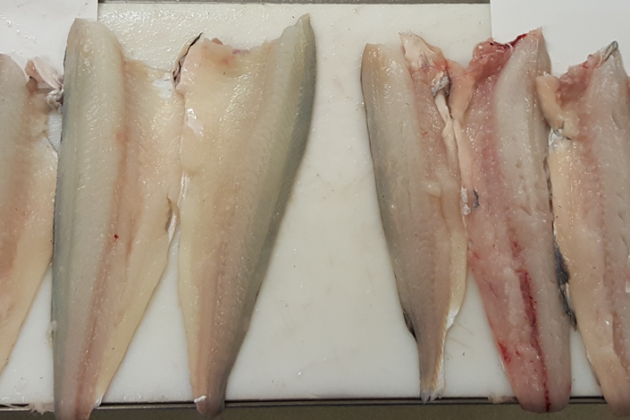Haddock quality better with live storage

Trials with live storage of haddock are showing very promising results. If haddock is caught alive and kept in tanks up to slaughter, high quality products may be produced of the entire catch.
Haddock is a good edible fish, but is difficult to handle. The reason is that it is more fragile and susceptible to stress during catching than cod.
The result is that the flesh easily splits and falls apart after slaughter. The fish can become so difficult to process that it becomes unsaleable.
It often ends up as a binding agent in fish food or block frozen in batter as a main ingredient in British fish and chips.
A loss for the fishing industry
The project with live storage before slaughter started last year. The background is that the fishing industry often incurs major losses on haddock catches.
There are two key challenges related to haddock quality. One is that the fish are processed after a few days of cold storage, which results in soft muscle. The second is blood in the muscle that largely arises from catching and handling on board.
The trials have involved live storage from catch to slaughter. This is done on board the vessel, not in pens as is the case with a small part of the cod quota.
Numerous researchers involved
In May this year, researchers from Nofima, the Institute for Marine Research and Sintef Ocean were involved in trials on the fishing vessel M/S Ballstadøy. The catches took place off the Finnmark coast.
They made several hauls with seine nets for haddock. Along the way different fishing gear configurations were tested to achieve the best possible survival.
After catching, the haddock was kept alive in tanks and delivered to the Båtsfjord facility, where it was slaughtered and processed. The delivery of live stored fish allowed for filleting of super-fresh haddock, which resulted in fillets without splitting and with little blood.
Fillets like jewellery
“The fillets we obtained from this looked like jewels. We obtained fillets of amazing quality that the Båtsfjord facility could produce to high quality products,” enthuses researcher Torbjørn Tobiassen.
The trial on board “Ballstadøy” involved optimizing conditions for the fish in the fishing gear. Among other things, an extender was used that provides more room in the purse seine when hauling in the catch.
More room results in less strain and a greater chance that the fish can breathe freely, which may affect survival and the amount of blood in the muscles.
Less stressed
“The haddock were remarkably calm when they came on board and were left alive in the tanks. We expected more stress, but only individuals expressed such behaviour. Animal welfare experts observed the fish in the tanks, and reported that they were very calm and doing well. In the trials, a survival rate of up to 80 per cent was achieved 12-18 hours after catching,” Tobiassen says.
When the haddock were slaughtered the next day, they were processed immediately.
“The Båtsfjord facility reported a significant quality improvement. They could cut whole, fine fillets with very little blood compared to traditional catches. There were no limitations to their production, and according to the employees this was a raw material that was very easy to work with,” Tobiassen says, who also received this feedback from the company:
“We can produce loins of all haddock you supply alive, and the proportion of high quality products increased by 25 per cent compared to traditional deliveries of haddock.”

Significant resource
“Haddock is a significant resource, but there is a lot of potential in terms of enhancing the quality in the value chain. We know that large individual catches, long transport times and storage in bulk causes product quality to significantly deteriorate. If we manage to develop effective solutions for alternative handling of fish, everyone in the value chain may benefit,” Tobiassen says.
The project is funded by FHF (the Fishery and Aquaculture Industry Research Fund) in close cooperation with industry partners (Båtsfjordbruket AS, Lerøy ASA and Nergård AS).
Haddock facts:
- Haddock is found at depths of 40 to 300 metres along the length of the coast from Stad to west of Svalbard.
- It thrives in flat areas with sand, clay or gravel.
- It feeds on small bottom-dwelling animals, octopus and fish.
- Young haddock in the Barents Sea are relatively attached to one place, while larger fish undertake long migrations.
- Haddock mature between the ages of two and five, when between 40 and 60 cm in length.
- Haddock spawns between March and June, and the most important spawning areas are on the banks off the coast of North Norway.
- Haddock may reach the age of 20 and weigh up to 19 kilos.
Source: godfisk.no
Contact person
Research facilities
